Sunday, 7 June 2009, Tallahassee to Troyes
Written 8 June 2009
We're here! And getting here went even more smoothly than usual. First, mirabile dictu, our taxi was on time! This is not an issue we've had good luck with in the past, so we allowed plenty of time, asking for an 11 a.m. pickup for a 2:30 p.m. flight (the drive to the airport is only 15 minutes). As it happened, we had a pleasant talk (some of it in French!) with our friendly German driver about the joys of Paris, then had plenty of time to check in, get through security (a breeze despite dire warnings from friends of long delays because only one security lane is working), have a leisurely lunch, and catch our flight, also right on time.
I was also pleasantly surprised by our experience of the Miami airport, which I remember as an absolute zoo the last time we flew to France through it. Yes, it was a little small for the number of people passing through it, but our arrival and departure gates were close together, we had time for a snack (hot chocolate and Cuban-style pastries, in anticipation of a late dinner), and still had time left to explore the marvelous art with which the concourse was decorated.

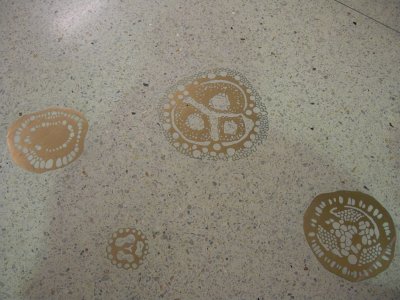 The floors were terrazzo inlaid with metal (brass? bronze?) motifs of plant life (some whole plants, some skeletonized leaves, some microscopic cross-sections, all different). So far as I could tell, in several hundred yards of walking, they never repeated. They reminded me strongly of the lobby floor in my new building (King Life Sciences at FSU), but were essentially monochrome. I wonder whether the same artist designed them who made our floor.
The floors were terrazzo inlaid with metal (brass? bronze?) motifs of plant life (some whole plants, some skeletonized leaves, some microscopic cross-sections, all different). So far as I could tell, in several hundred yards of walking, they never repeated. They reminded me strongly of the lobby floor in my new building (King Life Sciences at FSU), but were essentially monochrome. I wonder whether the same artist designed them who made our floor.
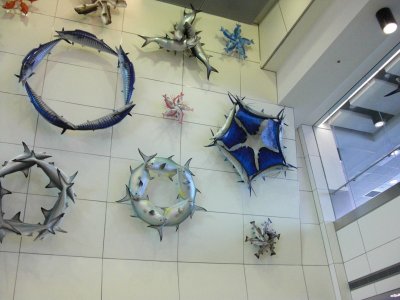
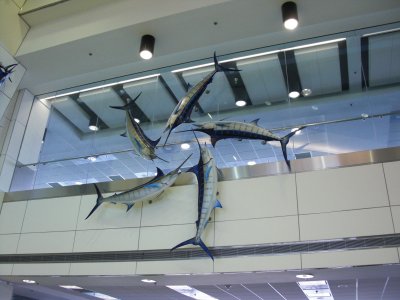 Even cooler, though, were the Wheels o' Fish which thickly covered the walls of one section. I have no idea what they were made of (painted fiberglass, maybe?), but they were magnificently detailed and lifelike! Most were life-size, but I think some were larger than life and a few smaller, and I was pleased at how many I could identify, at least to common name to about the level of genus. Now that's my idea of art. I'd love to have them on my walls at home, but we'd have to settle for the smaller ones— we haven't got a wall large enough to accommodate, e.g., these life-size swordfish.
Even cooler, though, were the Wheels o' Fish which thickly covered the walls of one section. I have no idea what they were made of (painted fiberglass, maybe?), but they were magnificently detailed and lifelike! Most were life-size, but I think some were larger than life and a few smaller, and I was pleased at how many I could identify, at least to common name to about the level of genus. Now that's my idea of art. I'd love to have them on my walls at home, but we'd have to settle for the smaller ones— we haven't got a wall large enough to accommodate, e.g., these life-size swordfish.
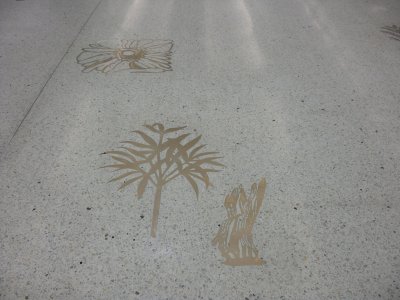 The airport's main disadvantage was the distinct shortage of electrical outlets. The janitors must use battery-powered vaccuum cleaners. Some phone company had provided charging posts for cell phones, but they were all in use and people were queuing for them.
The airport's main disadvantage was the distinct shortage of electrical outlets. The janitors must use battery-powered vaccuum cleaners. Some phone company had provided charging posts for cell phones, but they were all in use and people were queuing for them.
Everything was going swimmingly, and on time, until they actually tried to board our flight. The airport had suffered a major thunderstorm just before our flight from Tallahassee arrived, and apparently it had interefered with some of the place's electronics. All over the terminal, the electrically operated metal doors between the jetways and the terminal were malfunctioning and would not open! We stood around for a while, until an official arrived with some sort of key and they were able to pull them open by brute force. Even then they wouldn't stay open, and after a couple of minutes, if they were held open, a flashing light and loud alarm started up. They finally got the alarm to shut up, and we finally boarded while a security guard leaned on each half of the door, to hold it open.
The flight went entirely smoothly, and I was actually able to sleep for a while (which I usually have trouble doing on airplanes; David snored placidly throughout). A new wrinkle on this trip was "passenger locater forms," which we had to fill out because of "la grippe porcine," swine flu. We had to give contact information for everyplace we intended to be in the next 10 days, so that they could track us down if anybody we sat near on the plane came down with swine flu, and we had to promise to let them know if we came down with it. That meant writing out a whole list of phone numbers, all of which I fortunately had with me in my computer case.
In Paris, passport control and customs were even slicker and less obtrusive than usual, and we found ourselves conveniently close to the preferred Europcar rental counter—the one in the little shopping complex with minisupermarket, pharmacy, lunch restaurant, bookstore, and post office (this last closed, of course, on Sunday). While David rented the car, I got our usual six-pack of bottled water (to keep in the car; we start by drinking the bottled stuff, then refill the bottles from the tap for the rest of the trip) and some Supradyne (those fizzy vitamins David likes). After a light, early lunch, we adjourned to the the parking lot, where we found our cute, light-gray Fiat Panda waiting and were soon on our way to Troyes, in the southern part of Champagne—we had had to by-pass it during last year's trip to the that region, and it was conveniently located as a stop on our way to Burgundy.
We're a little later than we were last year, so the colza (oil-seed rape) has finished blooming (too bad—its fields of bright-yellow flowers are spectacular), but on the drive, we passed lots of that, plus lots of wheat and the awnless grain that I have tentatively identified as barley and a few fields each of broad beans, potatoes, sugar beets, very young sunflowers, and even younger corn.
We got to Troyes at 2:00 p.m., found our hotel despite the directions provided on its website, and pulled into its parking lot, only to discover it locked and dark. A sign on the door (and, they claim, on the website and in every reservation-confirmation message) explained that reception is closed from noon to 6:00 p.m. on Sundays; please come back later. Oookay. So we locked our luggage in the car, safe enough in its fenced and secluded parking lot, and set off on foot for the middle of town (about 1 km away) in seach of restrooms and four hours' diversion.
 We found the former (for a small fee) in the railway station. They opened off the loading platforms, where technically we weren't supposed to be without a train ticket, but the place was deserted so we encountered no problems. The tourist office was closed (it was still Sunday), but we studied the many posters in its window and learned of a number of exhibitions and musea, some of which might be open. We walked to the couscous restaurant I had tentatively chosen for our dinner and verified that, yes, it is open on Sunday, then strolled part of the Michelin-recommended pedestrian tour. Troyes (famously champagne-cork shaped, as this tourist map shows) is known for its 16th-century architecture. The town burned in the 16th century, at the height of a local economic boom, so it was rebuilt in a luxurious style, which at the time meant large and handsome (if not entirely rectilinear) half-timbered bourgeois houses, a great number of which survive. Most have been restored, and more are being worked on now. Some house musea, but the one we were interested in is closed not just Sundays but Mondays as well, so we'll miss it. Another was open, though—the Basilica of St. Jean-au-Marché housed a special exhibition (certified "of national interest") called "Le Beau XVIo (The Beautiful 16th Century) that consisted of 75 pieces of 16th-century religious sculpture from this region, mostly limestone and painted wood but a few in marble or alabaster, some up to life size and some in miniature. It included a particularly large number of St. Marys—some with the baby Jesus, some as a child herself being taught by St. Anne, some mourning the dead Jesus, all gorgeous. I especially like the work of Le Maître de Chaource (who might have been a guy named Jacques Bachot, though authorities aren't sure), all of whose figures have sad, triangular faces with flat cheekbones and downcast eyes (like this close-up of a female saint), but several other artists and studios were represented. One guy worked in miniature and was compared by a goldsmith. In his carved haute-relief of the last supper, perhaps a foot tall by four feet wide, you can see the details of each figure's finger- and toenails, the food on the table, and flowers carved on the legs of the table!
We found the former (for a small fee) in the railway station. They opened off the loading platforms, where technically we weren't supposed to be without a train ticket, but the place was deserted so we encountered no problems. The tourist office was closed (it was still Sunday), but we studied the many posters in its window and learned of a number of exhibitions and musea, some of which might be open. We walked to the couscous restaurant I had tentatively chosen for our dinner and verified that, yes, it is open on Sunday, then strolled part of the Michelin-recommended pedestrian tour. Troyes (famously champagne-cork shaped, as this tourist map shows) is known for its 16th-century architecture. The town burned in the 16th century, at the height of a local economic boom, so it was rebuilt in a luxurious style, which at the time meant large and handsome (if not entirely rectilinear) half-timbered bourgeois houses, a great number of which survive. Most have been restored, and more are being worked on now. Some house musea, but the one we were interested in is closed not just Sundays but Mondays as well, so we'll miss it. Another was open, though—the Basilica of St. Jean-au-Marché housed a special exhibition (certified "of national interest") called "Le Beau XVIo (The Beautiful 16th Century) that consisted of 75 pieces of 16th-century religious sculpture from this region, mostly limestone and painted wood but a few in marble or alabaster, some up to life size and some in miniature. It included a particularly large number of St. Marys—some with the baby Jesus, some as a child herself being taught by St. Anne, some mourning the dead Jesus, all gorgeous. I especially like the work of Le Maître de Chaource (who might have been a guy named Jacques Bachot, though authorities aren't sure), all of whose figures have sad, triangular faces with flat cheekbones and downcast eyes (like this close-up of a female saint), but several other artists and studios were represented. One guy worked in miniature and was compared by a goldsmith. In his carved haute-relief of the last supper, perhaps a foot tall by four feet wide, you can see the details of each figure's finger- and toenails, the food on the table, and flowers carved on the legs of the table!
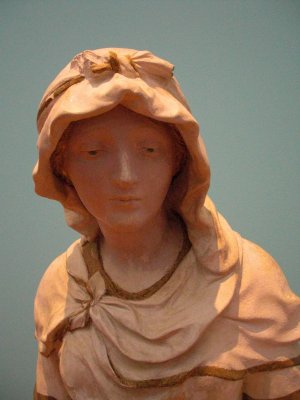
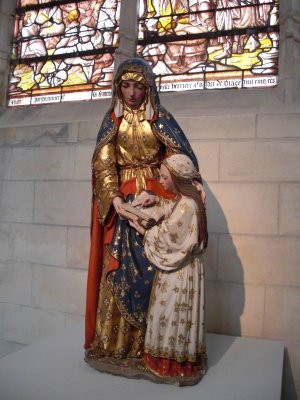 The church itself is also considered worth seeing, and in its vestibule is a large signboard on an inclined table laying out its floor plan and giving extensive descriptions, all in Braille! It must have a particularly large number of "touchable" scultures and works of art around the walls, but for the temporary exhibition, most were walled off with wooden partitions.
The church itself is also considered worth seeing, and in its vestibule is a large signboard on an inclined table laying out its floor plan and giving extensive descriptions, all in Braille! It must have a particularly large number of "touchable" scultures and works of art around the walls, but for the temporary exhibition, most were walled off with wooden partitions.
At one point, back outside, we walked through the famous "ruelle des chats" (cat alley), so called because the houses on opposite sides of it were so close together (and leaned even closer at the top) that cats could easily hop across the gap from one side to the other.
When our feet and energy gave out, we walked back to the hotel, arriving about 5:30 p.m., and found the lobby door standing open. It was still closed, but the proprietor was repainting the doors of some of the rooms (including ours) and had opened the door for air circulation, so we just camped in the lobby for half an hour, until the paint dried, reception opened, and our room was available. By that time, we were starving (it was noon, Tallahassee time, and our stomachs seemed of the opinion that the grilled cheese we had eaten seven hours before was too little too early, so we just unloaded the car, freshened up, and drove back into town. Parking was easy at that time of a Sunday night.
We arrived at the restaurant at 6:30 p.m.; it was open for drinks, but the kitchen didn't open until 7:00 p.m., so they seated us and brought me a bottle of water and David a pastis. It didn't take long to study the menu (7 appetizers, 6 kinds of couscous, 2 kinds of tajine, and 6 desserts). We knew even before we showed up that we wanted to start with "brik à l'oeuf." The tajines entailed a 45-min wait, so we just went for couscous—1 order of the fanciest ("royale," with chicken, grilled lamb, braised lamb, and merguez, i.e., lamb sausage) and 1 order of the simplest (just merguez). We didn't even read about the desserts, as we knew they would be irrelevant after the couscous.

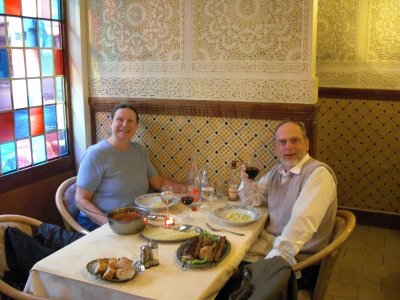 The brik, rather than being a single whole egg enveloped in pastry leaves and fried until "over easy," proved to be two eggs and capers folded into pastry leaves in the shape of a quesadilla, fried until well done, and served with a wedge of lemon. Different but delicious. (I've got to find a source for those pastry leaves. I have the recipe, but they sound like a bear to make from scratch, even more so than phyllo.) The couscous consisted, as usual, of a platter of the actual couscous (teensy-tiny little grains of fluffy pasta), a platter of meats, and a half-gallon basin of cooked vegetables in broth. On the table was a typical salt-peper-and-mustard service, but the mustard pot was filled with (even more incendiary than usual) harissa sauce. We finished all but a little couscous, part of one skewer of merguez (of three) and about a quart of the veggies and broth. Delicious!
The brik, rather than being a single whole egg enveloped in pastry leaves and fried until "over easy," proved to be two eggs and capers folded into pastry leaves in the shape of a quesadilla, fried until well done, and served with a wedge of lemon. Different but delicious. (I've got to find a source for those pastry leaves. I have the recipe, but they sound like a bear to make from scratch, even more so than phyllo.) The couscous consisted, as usual, of a platter of the actual couscous (teensy-tiny little grains of fluffy pasta), a platter of meats, and a half-gallon basin of cooked vegetables in broth. On the table was a typical salt-peper-and-mustard service, but the mustard pot was filled with (even more incendiary than usual) harissa sauce. We finished all but a little couscous, part of one skewer of merguez (of three) and about a quart of the veggies and broth. Delicious!
With his dinner, David enjoyed most of a half-bottle of Moroccan red wine, so I drove back to the hotel, without a hitch. Back at the hotel, in the room across from ours, an infant was screaming at the top of its lungs—no, wait (we listened more carefully), at least two infants, screaming simultaeously. Fortunately, within just a couple of minutes, somebody quieted them down, and we didn't hear a peep for the rest of the night. The trip is definitely off to a good start.
previous entry
List of Entries
next entry
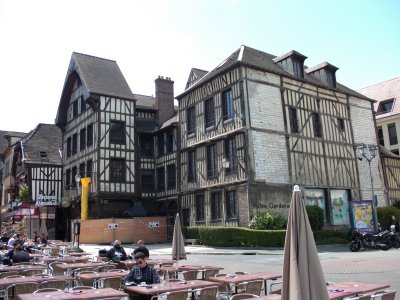

 The floors were terrazzo inlaid with metal (brass? bronze?) motifs of plant life (some whole plants, some skeletonized leaves, some microscopic cross-sections, all different). So far as I could tell, in several hundred yards of walking, they never repeated. They reminded me strongly of the lobby floor in my new building (King Life Sciences at FSU), but were essentially monochrome. I wonder whether the same artist designed them who made our floor.
The floors were terrazzo inlaid with metal (brass? bronze?) motifs of plant life (some whole plants, some skeletonized leaves, some microscopic cross-sections, all different). So far as I could tell, in several hundred yards of walking, they never repeated. They reminded me strongly of the lobby floor in my new building (King Life Sciences at FSU), but were essentially monochrome. I wonder whether the same artist designed them who made our floor.
 Even cooler, though, were the Wheels o' Fish which thickly covered the walls of one section. I have no idea what they were made of (painted fiberglass, maybe?), but they were magnificently detailed and lifelike! Most were life-size, but I think some were larger than life and a few smaller, and I was pleased at how many I could identify, at least to common name to about the level of genus. Now that's my idea of art. I'd love to have them on my walls at home, but we'd have to settle for the smaller ones— we haven't got a wall large enough to accommodate, e.g., these life-size swordfish.
Even cooler, though, were the Wheels o' Fish which thickly covered the walls of one section. I have no idea what they were made of (painted fiberglass, maybe?), but they were magnificently detailed and lifelike! Most were life-size, but I think some were larger than life and a few smaller, and I was pleased at how many I could identify, at least to common name to about the level of genus. Now that's my idea of art. I'd love to have them on my walls at home, but we'd have to settle for the smaller ones— we haven't got a wall large enough to accommodate, e.g., these life-size swordfish. The airport's main disadvantage was the distinct shortage of electrical outlets. The janitors must use battery-powered vaccuum cleaners. Some phone company had provided charging posts for cell phones, but they were all in use and people were queuing for them.
The airport's main disadvantage was the distinct shortage of electrical outlets. The janitors must use battery-powered vaccuum cleaners. Some phone company had provided charging posts for cell phones, but they were all in use and people were queuing for them. We found the former (for a small fee) in the railway station. They opened off the loading platforms, where technically we weren't supposed to be without a train ticket, but the place was deserted so we encountered no problems. The tourist office was closed (it was still Sunday), but we studied the many posters in its window and learned of a number of exhibitions and musea, some of which might be open. We walked to the couscous restaurant I had tentatively chosen for our dinner and verified that, yes, it is open on Sunday, then strolled part of the Michelin-recommended pedestrian tour. Troyes (famously champagne-cork shaped, as this tourist map shows) is known for its 16th-century architecture. The town burned in the 16th century, at the height of a local economic boom, so it was rebuilt in a luxurious style, which at the time meant large and handsome (if not entirely rectilinear) half-timbered bourgeois houses, a great number of which survive. Most have been restored, and more are being worked on now. Some house musea, but the one we were interested in is closed not just Sundays but Mondays as well, so we'll miss it. Another was open, though—the Basilica of St. Jean-au-Marché housed a special exhibition (certified "of national interest") called "Le Beau XVIo (The Beautiful 16th Century) that consisted of 75 pieces of 16th-century religious sculpture from this region, mostly limestone and painted wood but a few in marble or alabaster, some up to life size and some in miniature. It included a particularly large number of St. Marys—some with the baby Jesus, some as a child herself being taught by St. Anne, some mourning the dead Jesus, all gorgeous. I especially like the work of Le Maître de Chaource (who might have been a guy named Jacques Bachot, though authorities aren't sure), all of whose figures have sad, triangular faces with flat cheekbones and downcast eyes (like this close-up of a female saint), but several other artists and studios were represented. One guy worked in miniature and was compared by a goldsmith. In his carved haute-relief of the last supper, perhaps a foot tall by four feet wide, you can see the details of each figure's finger- and toenails, the food on the table, and flowers carved on the legs of the table!
We found the former (for a small fee) in the railway station. They opened off the loading platforms, where technically we weren't supposed to be without a train ticket, but the place was deserted so we encountered no problems. The tourist office was closed (it was still Sunday), but we studied the many posters in its window and learned of a number of exhibitions and musea, some of which might be open. We walked to the couscous restaurant I had tentatively chosen for our dinner and verified that, yes, it is open on Sunday, then strolled part of the Michelin-recommended pedestrian tour. Troyes (famously champagne-cork shaped, as this tourist map shows) is known for its 16th-century architecture. The town burned in the 16th century, at the height of a local economic boom, so it was rebuilt in a luxurious style, which at the time meant large and handsome (if not entirely rectilinear) half-timbered bourgeois houses, a great number of which survive. Most have been restored, and more are being worked on now. Some house musea, but the one we were interested in is closed not just Sundays but Mondays as well, so we'll miss it. Another was open, though—the Basilica of St. Jean-au-Marché housed a special exhibition (certified "of national interest") called "Le Beau XVIo (The Beautiful 16th Century) that consisted of 75 pieces of 16th-century religious sculpture from this region, mostly limestone and painted wood but a few in marble or alabaster, some up to life size and some in miniature. It included a particularly large number of St. Marys—some with the baby Jesus, some as a child herself being taught by St. Anne, some mourning the dead Jesus, all gorgeous. I especially like the work of Le Maître de Chaource (who might have been a guy named Jacques Bachot, though authorities aren't sure), all of whose figures have sad, triangular faces with flat cheekbones and downcast eyes (like this close-up of a female saint), but several other artists and studios were represented. One guy worked in miniature and was compared by a goldsmith. In his carved haute-relief of the last supper, perhaps a foot tall by four feet wide, you can see the details of each figure's finger- and toenails, the food on the table, and flowers carved on the legs of the table!
 The church itself is also considered worth seeing, and in its vestibule is a large signboard on an inclined table laying out its floor plan and giving extensive descriptions, all in Braille! It must have a particularly large number of "touchable" scultures and works of art around the walls, but for the temporary exhibition, most were walled off with wooden partitions.
The church itself is also considered worth seeing, and in its vestibule is a large signboard on an inclined table laying out its floor plan and giving extensive descriptions, all in Braille! It must have a particularly large number of "touchable" scultures and works of art around the walls, but for the temporary exhibition, most were walled off with wooden partitions.
 The brik, rather than being a single whole egg enveloped in pastry leaves and fried until "over easy," proved to be two eggs and capers folded into pastry leaves in the shape of a quesadilla, fried until well done, and served with a wedge of lemon. Different but delicious. (I've got to find a source for those pastry leaves. I have the recipe, but they sound like a bear to make from scratch, even more so than phyllo.) The couscous consisted, as usual, of a platter of the actual couscous (teensy-tiny little grains of fluffy pasta), a platter of meats, and a half-gallon basin of cooked vegetables in broth. On the table was a typical salt-peper-and-mustard service, but the mustard pot was filled with (even more incendiary than usual) harissa sauce. We finished all but a little couscous, part of one skewer of merguez (of three) and about a quart of the veggies and broth. Delicious!
The brik, rather than being a single whole egg enveloped in pastry leaves and fried until "over easy," proved to be two eggs and capers folded into pastry leaves in the shape of a quesadilla, fried until well done, and served with a wedge of lemon. Different but delicious. (I've got to find a source for those pastry leaves. I have the recipe, but they sound like a bear to make from scratch, even more so than phyllo.) The couscous consisted, as usual, of a platter of the actual couscous (teensy-tiny little grains of fluffy pasta), a platter of meats, and a half-gallon basin of cooked vegetables in broth. On the table was a typical salt-peper-and-mustard service, but the mustard pot was filled with (even more incendiary than usual) harissa sauce. We finished all but a little couscous, part of one skewer of merguez (of three) and about a quart of the veggies and broth. Delicious!